Fluted Blackwood Pier Mirror in Federation Style
You must be a subscriber, and be logged in to view price and dealer details.
Subscribe Now to view actual auction price for this item
When you subscribe, you have the option of setting the currency in which to display prices to $Au, $US, $NZ or Stg.
- Federation Period - The Federation style in architecture and furniture is broadly the Australian equivalent of the English Edwardian period and extended from 1890 to 1915. The name relates to Australia becoming a Federation in 1901, when the colonies became the Commonwealth of Australia.
- Fluting - A form of decoration found on many pieces of furniture, as well as ceramics, silver and clocks, in which round-bottomed grooves, of varying width and depth, are let into columns, pilasters, legs. As a general rule, flutes are cut in the vertical, though they may follow a turned leg in a spiral pattern. In cross-section, they may be described as a series of 'U' shapes, rising and narrowing at each end of the groove. Fluting is the opposite of reeding, with which fluting is often associated.
- Blackwood - One of the best known and most widely used Australian timbers, blackwood (acacia melanoxylon), is a member of the Acacia (wattle) family and grows in eastern Australia from about Adelaide in South Australia, as far north as Cairns in Queensland.
The largest, straightest and tallest trees come from the wet forest and swamps of north-west Tasmania where it is grown commercially.
Blackwood timber colours range across a wide spectrum, from a very pale honey colour through to a dark chocolate with streaks of red tinge.
The hardwood timber has been commonly used in the production of furniture, flooring, and musical instruments in Australia from the late 19th century. However, the straight grain timber is not the most prized or valuable, that honour falls to blackwood with a wavy, fiddleback pattern, which is used both in the solid and as a veneer. Fiddleback was only used on the finest examples of furniture.
This item has been included into following indexes:
-
mirrors, wall, period, age or style
- Louis style 361
- pier 112
Visually similar items

A French walnut 19th century armoire, the arched moulded cornice, above a mirrored door, flanked by canted corners, on block feet. 238 cm high, 108 cm wide, 41 cm deep.

An Australian cedar medicine cabinet with mirrored doors, 19th century 68 cm high, 52 cm wide, 31 cm deep

A Louis XV style French kingwood armoire, the lobed stepped rectangular cornice surmounted by an ormolu ribbon decoration, above a pair of mirrored doors enclosing three shelves with a pair of drawers below, and flanked by gilt pilasters on tapering short

Anthony Hordern & Sons Queensland maple wardrobe early 20th century, with keys, brass makers plaque inside door, 236 cm high, 164 cm long, 56.5 cm deep
